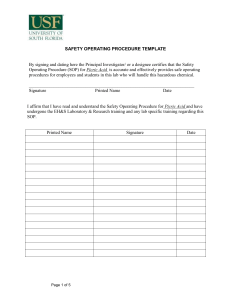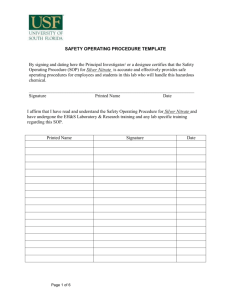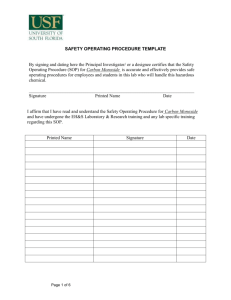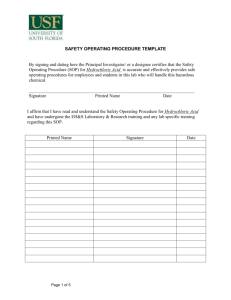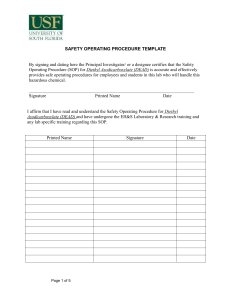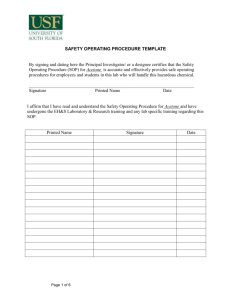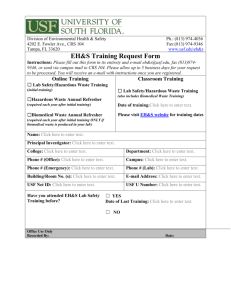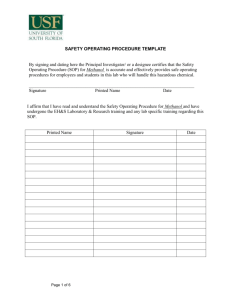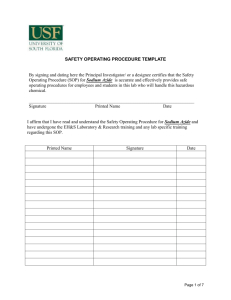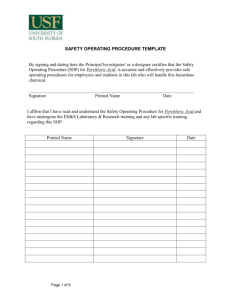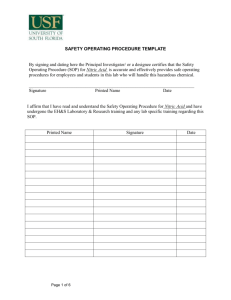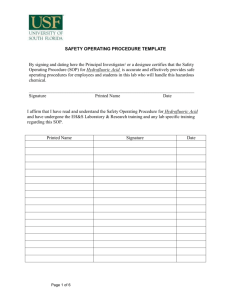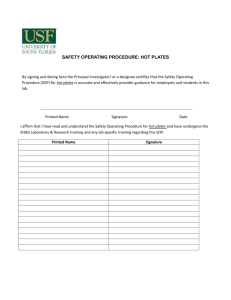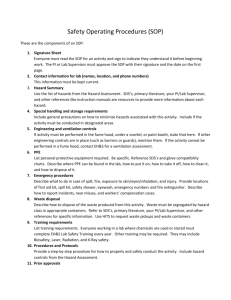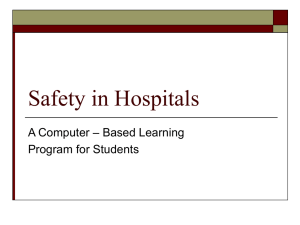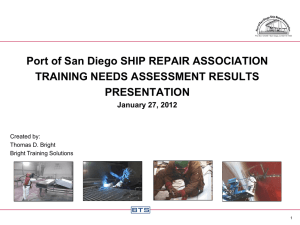Liquid Nitrogen - University of South Florida
advertisement
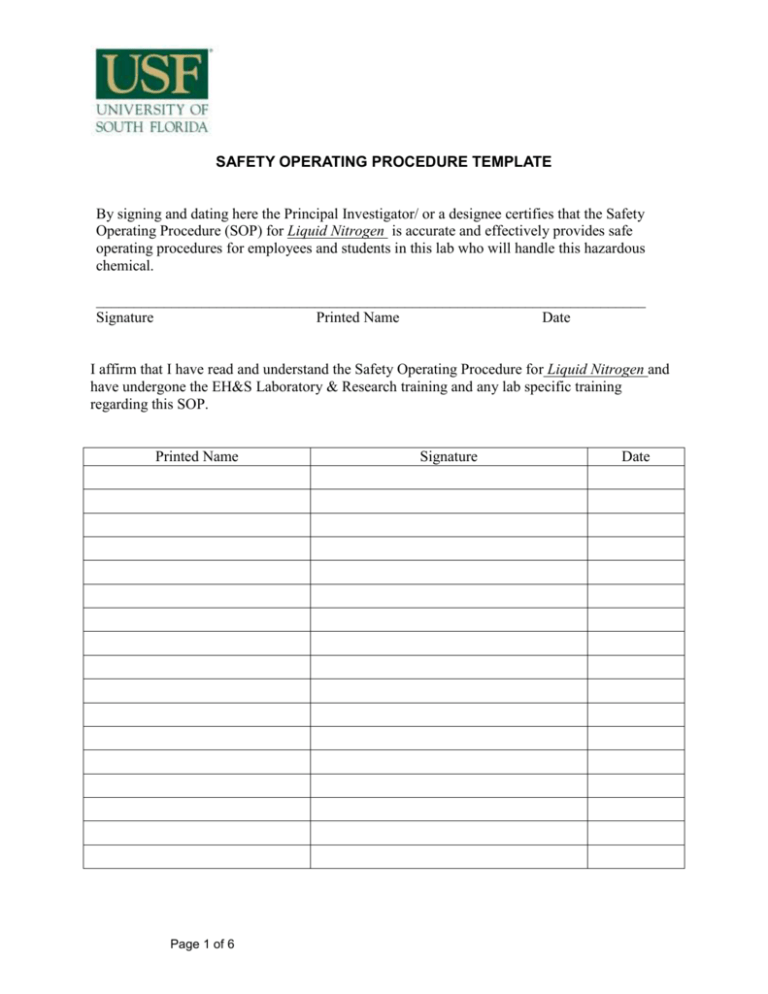
SAFETY OPERATING PROCEDURE TEMPLATE By signing and dating here the Principal Investigator/ or a designee certifies that the Safety Operating Procedure (SOP) for Liquid Nitrogen is accurate and effectively provides safe operating procedures for employees and students in this lab who will handle this hazardous chemical. _________________________________________________________________________ Signature Printed Name Date I affirm that I have read and understand the Safety Operating Procedure for Liquid Nitrogen and have undergone the EH&S Laboratory & Research training and any lab specific training regarding this SOP. Printed Name Page 1 of 6 Signature Date CONTACT INFORMATION: Liquid Nitrogen Chemical Name: CAS # 7727-37-9 Building/Room Number: Date of Creation/Revision 8/2/2012 Principal Investigator: Emergency Phone number: HAZARD SUMMARY Potential physical and health hazards associated with the use of this chemical include: Warning! Gas: Contents under pressure, do not puncture or incinerate container, can cause rapid suffocation, may cause severe frostbite Liquid: Extremely cold liquid and gas under pressure, can cause rapid suffocation, may cause severe frostbite, do not puncture or incinerate container, contact with rapidly expanding gases or liquids can cause frostbite No specific information available regarding other toxic effects on humans, no known significant effects or critical hazards regarding carcinogenic effects, mutagenic effects, reproduction toxicity, aquatic ecotoxicity is not available, no known significant effects or critical environmental hazards Eyes & skin: contact with rapidly expanding gas may cause burns or frostbite. Contact with cryogenic liquid can cause frostbite and cryogenic burns. Inhalation: Acts as a simple asphyxiant (route of entry) Ingestion: not a normal route of exposure for gases. Contact with cryogenic liquid can cause frostbite and cryogenic burns. Medical conditions aggravated by overexposure: acute or chronic respiratory conditions may be aggravated by overexposure to this gas SPECIAL HANDLING AND STORAGE REQUIREMENTS Describe special handling and storage requirements for this hazardous chemical in your laboratory, i.e. restricted access to chemical, inclusion of designated areas to limit and minimize possible sources of exposure to these materials. The entire laboratory, a portion of the laboratory, or a laboratory fume hood or bench may be considered a designated area. Special handling and storage requirements for this chemical include: Handling: High-pressure gas. Do not puncture or incinerate container. Use equipment rated for cylinder pressure. Close valve after each use and when empty. Protect cylinders from physical damage; do not drag, roll, Page 2 of 6 slide, or drop. Use a suitable hand truck for cylinder movement. Never allow any unprotected part of the body to touch uninsulated pipes or vessels that contain cryogenic liquids. Prevent entrapment of liquid in closed systems or piping without pressure relief devices. Some materials may become brittle at low temperatures and will easily fracture. When heated to decomposition it emits toxic nitrogen oxides fumes and hydrogen nitrate. Will react with water or steam to produce heat and toxic and corrosive fumes. Storage: Cylinders should be stored upright, with valve protection cap in place, and firmly secured to prevent falling or being knocked over. Cylinder temperatures should not exceed 52 oC (125 oF) Additional information is available in Compressed Gas Association pamphlets P-1 Safe Handling of Compressed Gases in Containers and P-12 Safe Handling of Cryogenic Liquids available from the Compressed Gas Association, Inc. ENGINEERING AND VENTILATION CONTROLS Include requirements for specific engineering/ventilation controls for this specific chemical, i.e. fume hood. If the process does not permit the handling of such materials in a fume hood, the lab personnel should contact Environmental Health and Safety at x4-4036 for review the adequacy of ventilation measures. Handling processes should be designed to minimize the potential for splash, splatter, or other likely scenarios for accidental contact. The handling of this chemical must be conducted in a fume hood. Additional engineering/ventilation controls for the handling of this chemical include: Use only with adequate ventilation. Use process enclosures, local exhaust ventilation or other engineering controls to keep worker exposure to airborne contaminants below any recommended or statutory limits. PERSONAL PROTECTIVE EQUIPMENT Include specific personal protective equipment required for the handling of this chemical. See the following references: 1. The USF Hazardous Inventory Tracking System (HITS) provides access to MSDS. 2. A glove compatibility chart provides specific information on the type of safety gloves that should be used based on the hazards of specific chemicals. 3. The following EH&S webpage provides links to glove manufacturers as well as other PPE selection resources, http://usfweb2.usf.edu/eh&s/labsafety/links.html. At minimum, safety glasses, lab coat, and gloves are to be worn when using this hazardous chemical. Additional PPE Requirements for the handling of this chemical include: appropriate clothing (long pants, close-toed shoes) gloves; indicate type:______________________________ safety goggles face shield □ □ flame-resistant lab coats other:__________________________ If the use of an N95, half mask, or full face respirator is requested, the individual and/or their supervisor must first contact Environmental Health & Safety for a consultation to determine if respirator Page 3 of 6 use is necessary. If EH&S determines the use of a respirator is necessary, the individual must participate in the University’s respirator program. This includes a medical evaluation; respirator fit test, and training. At minimum, safety glasses, lab coat, long pants, and closed toed shoes are to be worn when entering lab having dangerous chemicals. Insulated gloves – to be worn to protect oneself against accidental contact with liquid nitrogen. It is not meant for dipping into the liquid though. Goggles Eyes: Safety eyewear, wear a full face shield Skin: Personal protective equipment for the body should be selected based on the task being performed and the risks involved and should be approved by a specialist before handling Respiratory: Use a properly fitted, air-purifying or air-fed respirator complying with an approved standard if a risk assessment indicates this is necessary. Respirator selection must be based on known or anticipated exposure levels, the hazards of the product and the safe working limits of the selected respirator. The applicable standards are (US) 29 CFR 1910.134 and (Canada) Z94.4-93 Hands: Chemical-resistant, impervious gloves complying with an approved standard should be worn at all times when handling chemical products if a risk assessment indicates this is necessary. Insulated gloves suitable for low temperatures Personal protection in case of a large spill: Self-contained breathing apparatus (SCBA) should be used to avoid inhalation of the product EMERGENCY PROCEDURES If a there is a spill involving an extremely hazardous chemical, emergency responders should be contacted immediately. Dial 911 during and after normal business hours to contact the local emergency responders for your area and provide detail information to the emergency responders including chemical name, volume, hazards, spill location, and any injuries incurred. Building occupants can be notified of a building evacuation through the activation of a fire alarm pull station. Personnel: If lab personnel are exposed to an extremely hazardous chemical, call 911 immediately. Remove any contaminated clothing, and IMMEDIATELY flush contaminated skin with water for at least 15 minutes following any skin contact. For eye exposures, IMMEDIATELY flush eyes with water for at least 15 minutes. Consult MSDS for guidance on appropriate first aid. Where medical attention is required, ensure to bring along MSDS(s) of chemical(s) to aid medical staff in proper diagnosis and treatment. Fire and Emergency Evacuation Procedures: In case of fire or emergency situation, call 911 and or use emergency blue phone immediately to notify the fire emergency services and campus police. Immediately evacuate the building via the nearest exit when the fire alarm is activated. If unable to evacuate due to a disability, shelter in the area of rescue / refuge, typically a stairwell landing, and wait for assistance from drill volunteers or emergency responders. Instruct visitors and students to evacuate and assist them in locating the nearest exit. Do not use elevators to exit the building during an evacuation as they may become inoperable. Carry only those personal belongings that are within the immediate vicinity. Page 4 of 6 Close doors to limit the potential spread of smoke and fire. Terminate all hazardous operations and power off equipment. Close all hazardous materials containers. Remain outside of the building until the building is released for reentry. Do not restrict or impede the evacuation. Convene in the designated grassy gathering area and await instruction from emergency responders or drill volunteers. Avoid parking lots. Report fire alarm deficiencies, (e.g., trouble hearing the alarm) to facilities personnel for repair. Notify evacuation drill volunteers or emergency responders of persons sheltering in the areas of rescue/ refuge. Never assume that an alarm is a “false alarm”. Treat all fire alarm activations as emergencies. Get out of the building! If there is a spill, call EH&S, 4-4036. After hours, dial UPD at 911. Post notice on the door. Provide detail information to the emergency responders including chemical name, volume, hazards, spill location, and any injuries incurred. Keep unnecessary personnel away. Use suitable protective equipment. Notify the building occupants of a building evacuation by activating the fire alarm pull station. Avoid dispersal of spilled material and runoff and contact with soil, waterways, drains and sewers. Do not take any action involving any personal risk or without suitable training. If it is suspected that fumes are still present, the rescuer should wear an appropriate mask or self-contained breathing apparatus. It may be dangerous to the person providing aid to give mouth-to-mouth resuscitation. Eye contact: Check for and remove any contact lenses. Immediately flush eyes with plenty of water for at least 15 minutes, occasionally lifting the upper and lower eyelids. Get medical attention immediately. Skin contact: None expected. Frostbite: Try to warm up the frozen tissues and seek medical attention. Get medical attention immediately. Inhalation: Move the person to fresh air. If not breathing, if breathing is irregular or if respiratory arrest occurs, provide artificial respiration or oxygen by trained personnel. Loosen tight clothing such as a collar, tie, belt or waistband. Remove any contaminated clothing, immediately flush contaminated skin with water for at least 15 minutes following any skin contact. For eye exposures, immediately flush eyes with water for at least 15 minutes. The Laboratory/Studio and Field Incident Report form is to be completed by the Lab Manager/Teaching Assistant/Instructor for any incident that occurs in any University of South Florida affiliated teaching or research laboratory/studio or field research project. An incident means any unplanned event within the scope of a procedure that causes, or has the potential to cause, an injury or illness and/or damage to equipment, buildings, or the natural environment. Please fill out the online Laboratory/Studio and Field Incident Report form below and submit to Environmental Health & Safety within 24 hours of the incident. Due to medical privacy concerns, no personal identifying information of the person involved in the incident shall be entered or submitted with the form. http://usfweb2.usf.edu/eh&s/labsafety/LabIncident.html WASTE DISPOSAL Page 5 of 6 All chemical waste generated within USF System laboratories are considered hazardous waste and must be disposed of as hazardous waste in accordance with USF Hazardous Waste Management Procedure, the EPA, and the DEP. The USF Hazardous Waste Management Procedure can be found using the following link, http://compass.custhelp.com/app/answers/detail/a_id/1118/kw/hazardous%20waste. Avoid dispersal of spilled material and runoff and contact with soil, waterways, drains and sewers. Product removed from the cylinder must be disposed of in accordance with appropriate Federal, State local regulation. Return cylinders with residual product to Airgas, Inc. Do not dispose of locally. TRAINING REQUIREMENTS All individuals working with chemicals in USF laboratories must take EH&S’s Laboratory & Research Safety Training. To register for Laboratory & Research Training, please use the following link, http://usfweb2.usf.edu/eh&s/labsafety/tmaterials.html. However, the use of this chemical may warrant additional safety training per the PI, EH&S, or an authorizing unit such as the Biosafety or Radiation Safety programs. Additional training requirements are listed below. Training Requirements: Laboratory & Research Safety Training (EH&S) Research-specific Training (PI) □ Other _____________________________________________________________ PRIOR APPROVALS □ The handling of this chemical requires prior approval from the PI/designee. The handling of this chemical does not require prior approval from the PI/designee. Approval Signature (if required by PI) _________________________________________________________ Page 6 of 6
